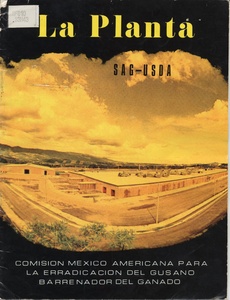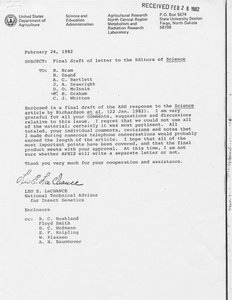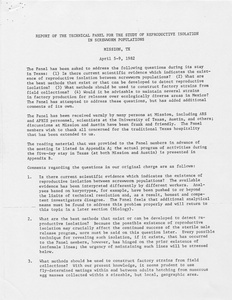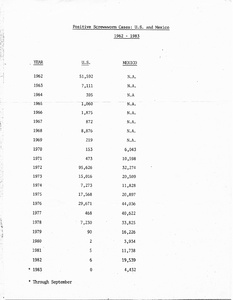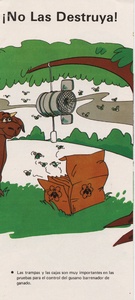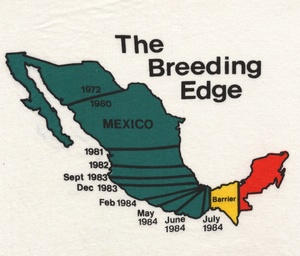1980s
Northern Mexico Declared Free of Self-Sustaining Screwworms
By 1980, the states of northern Mexico were free of self-sustaining screwworms. This was not only a boon to the ranchers and farmers of northern Mexico, but also moved the danger farther from U.S. borders. The fly release rates in Mexico consistently exceeded those in the United States. The work of the Mexico-United States Commission gained importance as the effort focused on central Mexico. In 1980, administrative chiefs of the Commission joined the technical conference for the first time.
United States Continues to Monitor Livestock
U.S. eradication officials encouraged livestock producers to treat all wounds and collect samples of any worms for laboratory analysis. Ranchers sent in thousands of reports and samples to county agents for analysis. This vigilance was very important in preventing new outbreaks.
Mission Plant Closes, Tuxtla Plant at Full Production
U.S. conditions were so positive that the fly-rearing facility in Mission, Texas, closed in 1981, its mission accomplished. The center of screwworm fly production was now the plant at Tuxtla Gutierrez, Chiapas, Mexico. The wetter climate of central and southern Mexico favored wild screwworm populations, as did the lack of temperatures cold enough to seasonally reduce the population. Less effective inspection procedures and the less-than-robust Mexican economy contributed to the difficulties faced by the eradication commission. Despite these difficulties and labor problems, the Tuxtla plant maintained a production level of 500 million sterile flies per week. The problem of reinfestation receded, and the Mexican government officially declared the north Mexican states of Sonora, Baja California Norte, and Baja California Sur free of screwworms in February 1982.
Reproductive Isolation
The issue of reproductive isolation had not been resolved. Were the screwworm flies of Mexico different enough from the lab-reared flies to prevent mating between fertile wild females and sterile lab males? ARS entomologists summarized their findings in a 1982 letter to Science. That same year experts outside USDA concluded that the success of the program demonstrated that these fly populations were compatible for mating.
United States Declares Its Last Positive Case of Screwworm Infestation
In 1982 the last case of screwworm was reported in the United States. Only a handful of imported cases have been reported since then.
Mexico-United States Commission Efforts for More Rancher Awareness
In 1984, Commission authorities intensified the public education campaign to make livestock producers in Mexico aware of the ongoing screwworm threat. Commission officials carried the same message to Mexico that had proven effective in the United States. Field agents provided informational literature and kits for collecting larvae. A kit contained a reporting form, collection tube, and a packet of wound treatment powder (Polvo 4072).
Screwworms Eradicated North and West of the 93rd Meridian in Mexico
The public education campaign played a critical role in the final eradication of screwworms north and west of the 93rd meridian at the Isthmus of Tehuantepec, the goal set by the 1972 agreement. The constant release of sterile flies in the zone, along with inspection stations that prevented infested livestock from reaching screwworm-free areas, maintained the barrier zone. In 1986, no outbreaks were reported north of the barrier zone. The goals of the 1972 International Agreement had been achieved.
 An official website of the United States government.
An official website of the United States government.




